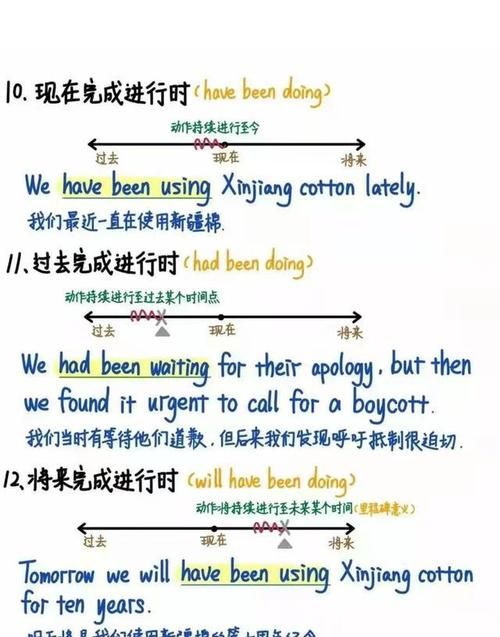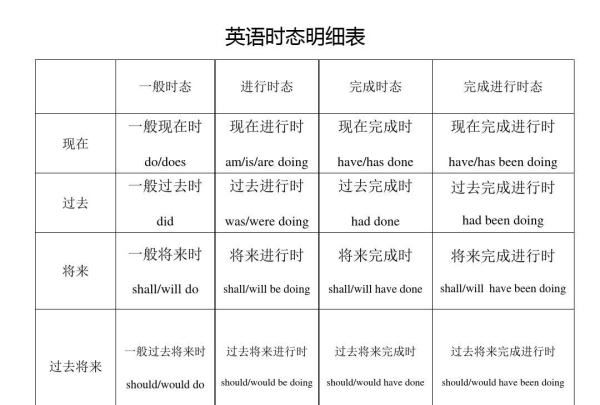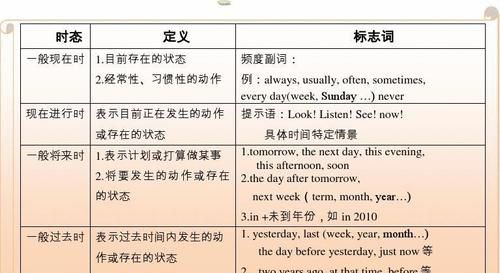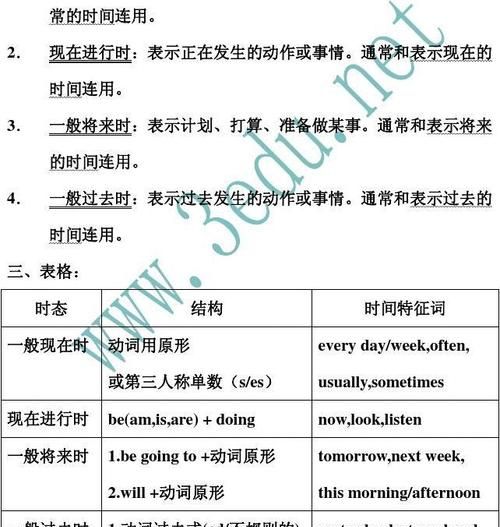本文目录
怎样判断英语句子时态
英语中如何辨别句子的时态 一般情况下看时间状语 一、一般现在时 表示一般状态、习惯动作、客观规律和永恒真理 二、现在进行时 表说话时或目前

怎样区分英语句子是什么时态
一、时态是什么
时态:表示一个动作发生的时间和所处的状态;时:动作发生的时刻,态:动作在某个时刻的样子,英语中一共有16种时态。

二、时态有哪些
各时态结构及用法:
1.一般现在时 (do/does; is/am/are)
①表示现在的情况、状态和特征。
② 表示经常性、习惯性动作。
③ 客观事实和普遍真理。
④ 表示一个按规定、计划或安排要发生的动作。(常用于列车、客车、飞机或轮船时刻表)
⑤ 主将从现:在时间、条件和让步状语从句中经常用一般现在表示将的来事情。
2. 现在进行时(am/is/are doing)
①表示此时此刻正在发生的事情。
②表示目前一段时间内一直在做的事情,但不一定此时此刻正在做。
③现在进行时可以表示将来的含义。
瞬时动词的进行一定表将来。
持续动词的进行只有有将来的时间状语或有将来语境中才表将来。
④现在进行时与频度副词连用,表示说话者或褒义或贬义的感情色彩。
3. 过去进行时(was/ were doing)
①表示在过去一个具体的时间正在发生的动作。
②表示过去某个时间段内一直在发生的事情。
③过去进行时可以表示过去将来的含义。
持续动词的过去进行时只有在有过去将来的时间状语或过去将来的语境下才能表示过去将来。
④过去进行时和频度副词连用可以表示说话者或褒义或贬义的感情色彩。
4. 一般将来时
①基本结构是will do。
②表示“打算…,要…”时,可用 am/is/are going to do。
③ 表示“即将、正要”时,可用am/is/are about to do。强调近期内或马上要做的事。
④"be to do"的2种用法:
a) 表示“按计划、安排即将发生某事或打算做某事”。
b) 该做或不该做的事情(语气上接近于should, must, ought to, have to),表示一种命令、规劝性语气。
5. 将来进行时(will be doing)
强调在将来的某个具体时间正在发生的动作或存在的状态。
6. 过去将来时(would do)
表示从过去的某个时间看将要发生的事。
7.过去将来进行时:( would be doing )
强调在过去将来的某个具体时间正在发生的动作或存在的状态。
8. 一般过去时 (did; was/were)
①表示过去某个时间发生的动作或情况。
②表示过去习惯性动作。would/ used to do:过去常常......
9. 现在完成时(have/has done)
①表示动作到现在为止已经完成或刚刚完成,强调对现在产生的影响。
②表示从过去某时刻开始,持续到现在的动作或情况,并且有可能会继续延续下去。此时经常用延续性动词。时间状语常用since加一个过去的时间点,或for加一段时间,或by加一个现在时间。
10. 现在完成进行时(have/has been doing)
表示某一动作开始于过去某一时间,延续或重复地出现至今,或将继续延续至将来。
11. 过去完成时(had done)
①表示在过去的某个时间或动作以前已经完成的动作或已经存在的状态。就是我们常说的"过去的过去"。
②表示从过去的过去开始,持续到过去的动作或情况,并且有可能会继续延续下去。此时经常用延续性动词。
12.过去完成进行时:had been doing
表示从过去的过去开始,持续到过去的动作或情况,期间一直有规律的在进行、不曾间断,并且有可能会继续延续下去。此时经常用延续性动词。
13.过去将来完成时:(would have done)
表示到过去将来某一时间已经完成的动作,并且对过去将来那一时间点产生影响。
表示动作从过去某一时间开始一直延续到过去将来某一时间,并且有可能继续延续下去。
14.过去将来完成进行时:(would have been doing)
表示动作从过去某一时间开始一直延续到过去将来某一时间,期间一直有规律在进行、不曾间断,并且有可能继续延续下去。
15. 将来完成时(will have done)
①表示一个动作到将来某个时间为止已经完成,强调对将来那个时间产生的影响。
②表示一个动作延续到将来某个时间,并且有可能继续延续下去。
16.将来完成进行时:(will have been doing)
表示一个动作延续到将来某个时间,期间一直有规律在进行、不曾间断,并且有可能继续延续下去。
英语中如何辨别句子的时态和结构
一般情况下看时间状语
一、一般现在时 表示一般状态、习惯动作、客观规律和永恒真理
二、现在进行时 表说话时或目前一段时间内正在进行的活动;或表感情色彩,加强浯气.
三、现在完成时 表目前已完成的动作,强调对现在的影响.时间是算到你说话的时候为止,而且现在完成时有一些标志性的时间状语: 1.for+时间段;I have learned English for ten years. 2.常见的副词:lately;recently, just,up to now, till now, so far, these days, in the past few years/months/weeks/days 3.注意:for+时间段;since+时间点 They have lived in Beijing for five years. They have lived in Beijing since l995. 4.This is the first time that I have watched stars through a telescope. 第几次做某事,后面跟现在完成时.
四、一般过去时 表在过去某个特定时间发生且完成的动作,或过去习惯性动作,不强调对现在的影响,只说明过去.常跟明确的过去时间连用,如:yesterday;last week;in 1945,at that time;once;during the war;before;a few days ago;when,注意: 1、used to+动词原形,表过去经常但现在已不再维持的习惯动作. He used to smoke. 2、be/become/get used to+动名词doing,表习惯于 He has got used to getting up early. He used to smoke a lot. 3、They have lived in Beijing for five years. 用现在完成时表示到目前是5年. He lived in Japan for five years as a middle-school student. 用一般过去时则表示这个时间段和现在无关,只表示他过去在日本住了5年.
五、过去进行时 表示过去某个时间点或某段时间内正在发生的动作. The boy was doing his homework when his father came back from work. He was taking a leisurely walk by the lake when he heard someone shouted for help. 六、过去完成时 表示过去某个时间之前已经完成的动作,句中有明显的参照动作或时间,before,after,by,up till There had been 25 parks in our city up till 2000. By the end of last term we had finished the book. They finished earlier than we had expected.
一 ,一般现在时的用法
1) 经常性或习惯性的动作,常与表示频度的时间状语连用.时间状语: every…, sometimes, at…, on Sunday.例如: I leave home for school at 7 every morning.
2) 客观真理,客观存在,科学事实.例如: The earth moves around the sun. 3 现在时刻的状态、能力、性格、个性.例如:I don't want so much. 我不要那么多. Ann writes good English but does not speak well. 安英语写得不错,讲的可不行.
二, 一般过去时的用法
1)在确定的过去时间里所发生的动作或存在的状态.例如:时间状语有:yesterday, last week, an hour ago, the other day, in 1982等.例如: Where did you go just now?
2)表示在过去一段时间内,经常性或习惯性的动作.例如: When I was a child, I often played football in the street. 我是个孩子的时候,常在马路上踢足球.
三, 一般将来时 将来某一时刻将要发生的动作或状态I will come to see you tomorrow.
2)be going to do a. 主语的意图,即将做某事.例如:What are you going to do tomorrow? b. 计划,安排要发生的事.例如:The play is going to be produced next month.这出戏下月开播.c. 有迹象要发生的事.例如:Look at the dark clouds, there is going to be a storm. 看那乌云,快要下雨了.
3)be +不定式表将来,按计划或正式安排将发生的事. We are to discuss the report next Saturday.
4)be about to do,意为马上做某事.例如: He is about to leave for Beijing. 注意:be about to do 不能与tomorrow, next week 等表示明确将来时的时间状语连用.
四 , 现在进行时现在进行时的基本用法: a. 表示现在(指说话人说话时)正在发生的事情.We are waiting for you. b. 习惯进行:表示长期的或重复性的动作, Mr. Green is writing another novel. 他在写另一部小说.(说话时并未在写,只处于写作的状态.) c. 表示渐变,这样的动词有:get, grow, become, turn, run, go, begin等. It's getting warmer and warmer. 天越来越热了. d. 与always, constantly, forever 等词连用,表示反复发生的动作或持续存在的状态,往往带有说话人的主观色彩.You are always changing your mind. 你老是改变主意
五, 过去进行时
1)概念:表示过去某时正在进行的状态或动作.
2)常用的时间状语有this morning, the whole morning, all day yesterday, from nine to ten last evening, when, while等.My brother fell while he was riding his bicycle and hurt himself. It was raining when they left the station.
六,将来进行时
1) 概念:表示将来某时进行的状态或动作,或按预测将来会发生的事情.She'll be coming soon.
2)常用的时间状语有soon, tomorrow, this evening,on Sunday, by this time,tomorrow, in two days, tomorrow evening等.例如:By this time tomorrow, I'll be lying on the beach.
七,在完成时 用来表示之前已发生或完成的动作或状态,其结果的影响现在还存在;也可表示持续到现在的动作或状态.其构成:have(has)+过去分词.
现在完成时例句Tom has finished his home work and he is watching TV now.(完成作业是过去的动作,但对现在造成了影响,用现在完成时)He has lived here for 5 years.(居住的动作从5年前一直持续到现在,用现在完成时.)现在完成时时间状语:ever,many times,recently,just,yet,already,before等.八 过去完成时结构 主语+had+过去分词 表示过去某一动作或时刻之前完成的动作或状态,即过去的过去.时间状语:by,before,until,when例句 When Jack arrived,he learned Mary had been away for almost an hour.(Mary 离开在Jack到达这个过去的动作之前发生,用过去完成时)
-----------
引导时间状语的句子通常附有时间名词,若无,必须经过上下文的推敲来得知是否改用时间状语,其引导词通常有when,while,before,after等.时间状语只是属于复合句的一种,不属于动词时态.但往往动词时态会运用于时间状语中.动词时态一共有16中,每一种都有可能用于时间状语

怎样判断英语句子时态
一般情况下看时间状语 一、一般现在时 表示一般状态、习惯动作、客观规律和永恒真理 二、现在进行时 表说话时或目前一段时间内正在进行的活动;或表感情色彩,加强浯气。 三、现在完成时 表目前已完成的动作,强调对现在的影响。时间是算到你说话的时候为止,而且现在完成时有一些标志性的时间状语: 1.for+时间段;I have learned English for ten years. 2.常见的副词:lately;recently, just,up to now, till now, so far, these days, in the past few years/months/weeks/days 3.注意:for+时间段;since+时间点 They have lived in Beijing for five years. They have lived in Beijing since l995. 4.This is the first time that I have watched stars through a telescope. 第几次做某事,后面跟现在完成时。 四、一般过去时 表在过去某个特定时间发生且完成的动作,或过去习惯性动作,不强调对现在的影响,只说明过去。常跟明确的过去时间连用,如:yesterday;last week;in 1945,at that time;once;during the war;before;a few days ago;when,注意: 1、used to+动词原形,表过去经常但现在已不再维持的习惯动作。 He used to smoke. 2、be/become/get used to+动名词doing,表习惯于 He has got used to getting up early. He used to smoke a lot. 3、They have lived in Beijing for five years. 用现在完成时表示到目前是5年。 He lived in Japan for five years as a middle-school student. 用一般过去时则表示这个时间段和现在无关,只表示他过去在日本住了5年。 五、过去进行时 表示过去某个时间点或某段时间内正在发生的动作。 The boy was doing his homework when his father came back from work. He was taking a leisurely walk by the lake when he heard someone shouted for help. 六、过去完成时 表示过去某个时间之前已经完成的动作,句中有明显的参照动作或时间,before,after,by,up till There had been 25 parks in our city up till 2000. By the end of last term we had finished the book. They finished earlier than we had expected. 一 ,一般现在时的用法 1) 经常性或习惯性的动作,常与表示频度的时间状语连用。时间状语: every…, sometimes, at…, on Sunday。例如: I leave home for school at 7 every morning. 2) 客观真理,客观存在,科学事实。例如: The earth moves around the sun. 3 现在时刻的状态、能力、性格、个性。例如:I don't want so much. 我不要那么多。 Ann writes good English but does not speak well. 安英语写得不错,讲的可不行。 二, 一般过去时的用法 2)表示在过去一段时间内,经常性或习惯性的动作。例如: When I was a child, I often played football in the street. 我是个孩子的时候,常在马路上踢足球。 三, 一般将来时 将来某一时刻将要发生的动作或状态I will come to see you tomorrow. 2)be going to do a. 主语的意图,即将做某事。例如:What are you going to do tomorrow? b. 计划,安排要发生的事。例如:The play is going to be produced next month。这出戏下月开播。c. 有迹象要发生的事。例如:Look at the dark clouds, there is going to be a storm. 看那乌云,快要下雨了。 3)be +不定式表将来,按计划或正式安排将发生的事。 We are to discuss the report next Saturday. 4)be about to do,意为马上做某事。例如: He is about to leave for Beijing. 注意:be about to do 不能与tomorrow, next week 等表示明确将来时的时间状语连用。 四 , 现在进行时现在进行时的基本用法: a. 表示现在(指说话人说话时)正在发生的事情。We are waiting for you. b. 习惯进行:表示长期的或重复性的动作, Mr. Green is writing another novel. 他在写另一部小说。(说话时并未在写,只处于写作的状态。) c. 表示渐变,这样的动词有:get, grow, become, turn, run, go, begin等。 It's getting warmer and warmer. 天越来越热了。 d. 与always, constantly, forever 等词连用,表示反复发生的动作或持续存在的状态,往往带有说话人的主观色彩。You are always changing your mind. 你老是改变主意 五, 过去进行时 1)概念:表示过去某时正在进行的状态或动作。 2)常用的时间状语有this morning, the whole morning, all day yesterday, from nine to ten last evening, when, while等。My brother fell while he was riding his bicycle and hurt himself. It was raining when they left the station. 六,将来进行时 1) 概念:表示将来某时进行的状态或动作,或按预测将来会发生的事情。She'll be coming soon. 2)常用的时间状语有soon, tomorrow, this evening,on Sunday, by this time,tomorrow, in two days, tomorrow evening等。例如:By this time tomorrow, I'll be lying on the beach. 七,在完成时 用来表示之前已发生或完成的动作或状态,其结果的影响现在还存在;也可表示持续到现在的动作或状态。其构成:have(has)+过去分词。 现在完成时例句Tom has finished his home work and he is watching TV now.(完成作业是过去的动作,但对现在造成了影响,用现在完成时)He has lived here for 5 years.(居住的动作从5年前一直持续到现在,用现在完成时。)现在完成时时间状语:ever,many times,recently,just,yet,already,before等。八 过去完成时结构 主语+had+过去分词 表示过去某一动作或时刻之前完成的动作或状态,即过去的过去。时间状语:by,before,until,when例句 When Jack arrived,he learned Mary had been away for almost an hour.(Mary 离开在Jack到达这个过去的动作之前发生,用过去完成时) 引导时间状语的句子通常附有时间名词,若无,必须经过上下文的推敲来得知是否改用时间状语,其引导词通常有when,while,before,after等。时间状语只是属于复合句的一种,不属于动词时态。但往往动词时态会运用于时间状语中。

以上就是关于如何判断英语句子是什么时态 ,怎样判断英语句子时态的全部内容,以及如何判断英语句子是什么时态 的相关内容,希望能够帮到您。
